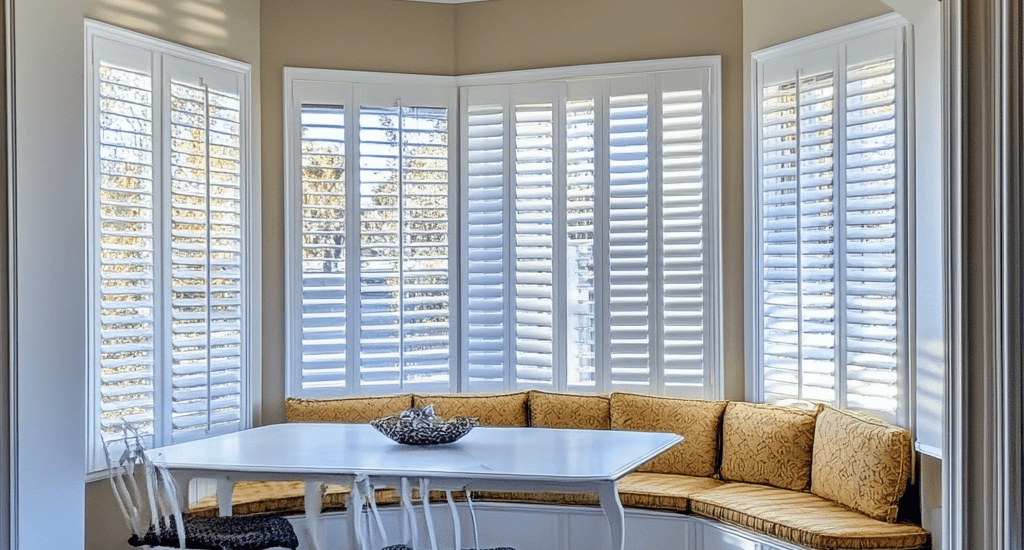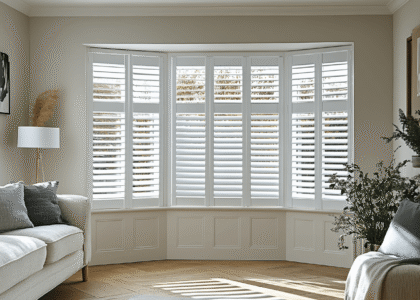California Shutters are a popular and timeless window treatment that adds charm, privacy, and functionality to any home. However, like any home accessory, they’re not without their occasional hiccups. From stuck louvers to peeling paint, these issues can crop up over time. But don’t worry — most of these problems are fixable with a little know-how and effort.
In this blog, we’ll walk you through the most common problems with California Shutters and provide actionable solutions for each one. Whether you’re dealing with warping wood or stiff hinges, this guide will help you keep your shutters in tip-top shape.
1. Stuck or Hard-to-Move Louvers in California Shutters
The Problem:
Over time, you might notice that the louvers (the adjustable slats) on your California Shutters become stiff or refuse to budge altogether. This is often caused by dust and grime building up in the pivot joints, or wear and tear from everyday use.
How to Fix It:
- Step 1: Start by cleaning the louvers and joints. Use a soft microfiber cloth or a small brush to remove dust from hard-to-reach areas. If the buildup is stubborn, lightly dampen the cloth with a mild soap solution and wipe gently. Avoid soaking wooden shutters.
- Step 2: Apply a silicone spray lubricant or dry graphite lubricant (for wooden shutters) to the pivot points. Avoid oil-based lubricants, as they can attract dust and create a sticky mess.
- Step 3: Test the louvers by gently moving them back and forth until they glide smoothly again.
Prevention Tip: Dust your shutters regularly — once a week is ideal — to prevent debris buildup in the joints.
2. Warping or Cracking Panels in Wood California Shutters
The Problem:
Wooden California Shutters are prone to warping, cracking, or swelling when exposed to excess moisture or extreme temperature changes. This can lead to misalignment and difficulty in operation.
How to Fix It:
- Minor Warping: Place the warped panel on a flat surface and gently press it back into shape. Secure it with clamps overnight to restore its form.
- Cracks or Splits: Fill minor cracks with wood filler, sand the area lightly once it’s dry, and repaint or stain to match the shutter’s original finish.
- Severe Damage: If the warping or cracking is beyond repair, you’ll likely need to replace the panel entirely.
Prevention Tip: Avoid installing wooden shutters in high-humidity areas like bathrooms or kitchens. If you must, apply a protective sealant to guard against moisture. Alternatively, consider vinyl shutters, which are moisture-resistant and less prone to damage.
3. Loose or Wobbly Hinges in California Shutters
The Problem:
With frequent use, the hinges holding your shutter panels in place can loosen, causing the shutters to wobble or sag. This can lead to misalignment, uneven panels, and difficulty in opening and closing the shutters.
How to Fix It:
- Step 1: Tighten the screws on the loose hinges using a screwdriver.
- Step 2: If the screws no longer hold tightly (due to stripped screw holes), fill the holes with wood filler. Allow it to dry, then reinsert the screws.
- Step 3: For severely worn or damaged hinges, replace them with new ones from your shutter manufacturer or a hardware store.
Prevention Tip: Regularly check the hinges and screws for any signs of loosening and tighten them as needed.
4. Faded or Peeling Paint on California Shutters
The Problem:
Prolonged exposure to sunlight can cause the paint on your shutters to fade or peel, especially on wooden shutters. This can make your once-stunning window treatments look tired and neglected.
How to Fix It:
- Step 1: Sand the affected area lightly to remove peeling paint and create a smooth surface.
- Step 2: Clean the area with a damp cloth to remove dust and debris.
- Step 3: Repaint or restain the shutters using high-quality, UV-resistant paint or stain. Be sure to match the existing color for a seamless look.
Prevention Tip: Install UV-blocking window films or curtains to reduce sun exposure and protect your shutters’ finish.
5. Uneven Louvers or Gaps in California Shutters
The Problem:
Over time, the louvers in your California Shutters may not close evenly, or you may notice gaps between the panels. This is often caused by loose tension screws or warped panels.
How to Fix It:
- Step 1: Check the tension screws located in the shutter frame. These control the tightness of the louvers. Tighten them slightly using a screwdriver. Be careful not to overtighten, as this can make the louvers too stiff to adjust.
- Step 2: For gaps caused by warped panels, follow the steps outlined in Section 2 (Warping or Cracking Panels).
- Step 3: If gaps persist despite your efforts, contact a professional for adjustments or repairs.
Prevention Tip: Regular maintenance and cleaning can help prevent alignment issues before they start.
6. What to Do When California Shutters Are Hard to Open or Close
The Problem:
Shutters that stick or don’t open/close smoothly can be frustrating. This can result from sticky hinges, misaligned panels, or debris obstructing the shutter’s movement.
How to Fix It:
- Sticky Hinges: Clean the hinges with a brush or cloth and apply a small amount of silicone spray lubricant.
- Misalignment: Tighten loose screws or adjust the hinges for better alignment.
- Obstructions: Inspect the frame and panels for debris or buildup and remove it.
Prevention Tip: Avoid slamming or forcing shutters open and closed, as this can lead to alignment problems and damage over time.
California Shutters are a beautiful and functional addition to any home, but like anything else, they require some TLC to stay in great shape. By addressing these common problems early and following simple maintenance tips, you can extend the life of your shutters and keep them looking and working like new.
For severe damage or repairs that are beyond your expertise, don’t hesitate to call a professional. They’ll have the tools and experience to fix your shutters without compromising their quality.
Trying to decide between plantation shutters and California shutters? Our blog, Plantation Shutters vs. California Shutters, breaks down the differences — from design to cost — so you can choose what’s right for your home.
Learn more about California Shutters:
Conclusion
California Shutters are an investment in both style and functionality, but like any feature in your home, they need proper care to stand the test of time. With the tips and fixes shared above, you can tackle common issues such as stuck louvers, warped panels, or peeling paint with confidence. A little maintenance can go a long way in preserving their charm and performance.
If your shutters need a professional touch or you’re ready to replace damaged parts, it’s always wise to seek expert help. Don’t let minor issues turn into bigger problems — keep your shutters in top Contact us at Ava Shutters,today. Reach out to a trusted shutter repair service or shop for high-quality replacement parts to keep your home looking its best!






